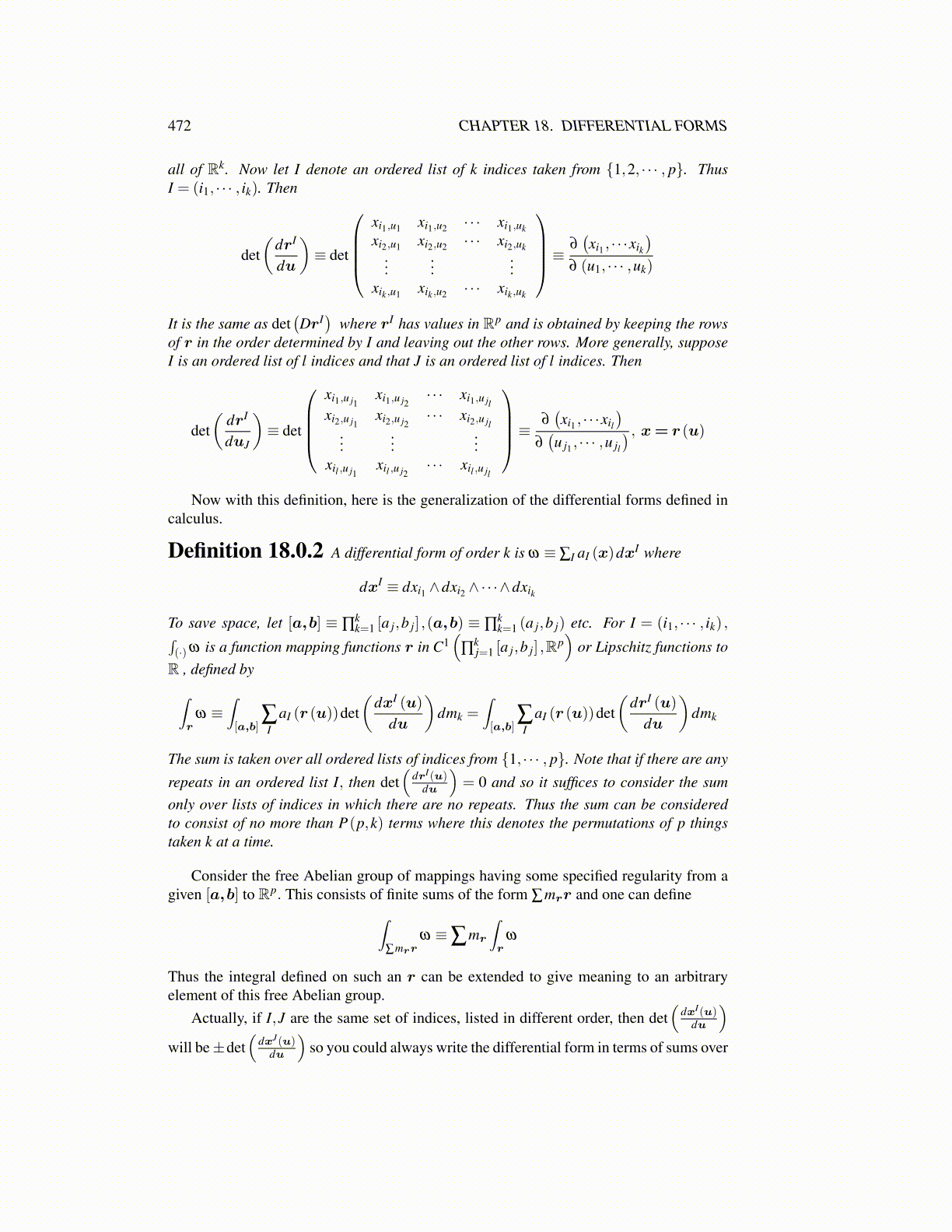
472 CHAPTER 18. DIFFERENTIAL FORMS
all of Rk. Now let I denote an ordered list of k indices taken from {1,2, · · · , p}. ThusI = (i1, · · · , ik). Then
det(
drI
du
)≡ det
xi1,u1 xi1,u2 · · · xi1,ukxi2,u1 xi2,u2 · · · xi2,uk
......
...xik,u1 xik,u2 · · · xik,uk
≡ ∂(xi1 , · · ·xik
)∂ (u1, · · · ,uk)
It is the same as det(DrI
)where rI has values in Rp and is obtained by keeping the rows
of r in the order determined by I and leaving out the other rows. More generally, supposeI is an ordered list of l indices and that J is an ordered list of l indices. Then
det(
drI
duJ
)≡ det
xi1,u j1
xi1,u j2· · · xi1,u jl
xi2,u j1xi2,u j2
· · · xi2,u jl...
......
xil ,u j1xil ,u j2
· · · xil ,u jl
≡ ∂(xi1 , · · ·xil
)∂(u j1 , · · · ,u jl
) , x= r (u)
Now with this definition, here is the generalization of the differential forms defined incalculus.
Definition 18.0.2 A differential form of order k is ω ≡ ∑I aI (x)dxI where
dxI ≡ dxi1 ∧dxi2 ∧·· ·∧dxik
To save space, let [a,b] ≡ ∏kk=1 [a j,b j] ,(a,b) ≡ ∏
kk=1 (a j,b j) etc. For I = (i1, · · · , ik) ,∫
(·) ω is a function mapping functions r in C1(
∏kj=1 [a j,b j] ,Rp
)or Lipschitz functions to
R , defined by∫r
ω ≡∫[a,b]
∑I
aI (r (u))det(
dxI (u)
du
)dmk =
∫[a,b]
∑I
aI (r (u))det(
drI (u)
du
)dmk
The sum is taken over all ordered lists of indices from {1, · · · , p}. Note that if there are any
repeats in an ordered list I, then det(
drI(u)du
)= 0 and so it suffices to consider the sum
only over lists of indices in which there are no repeats. Thus the sum can be consideredto consist of no more than P(p,k) terms where this denotes the permutations of p thingstaken k at a time.
Consider the free Abelian group of mappings having some specified regularity from agiven [a,b] to Rp. This consists of finite sums of the form ∑mrr and one can define∫
∑mrrω ≡∑mr
∫r
ω
Thus the integral defined on such an r can be extended to give meaning to an arbitraryelement of this free Abelian group.
Actually, if I,J are the same set of indices, listed in different order, then det(
dxI(u)du
)will be±det
(dxJ(u)
du
)so you could always write the differential form in terms of sums over